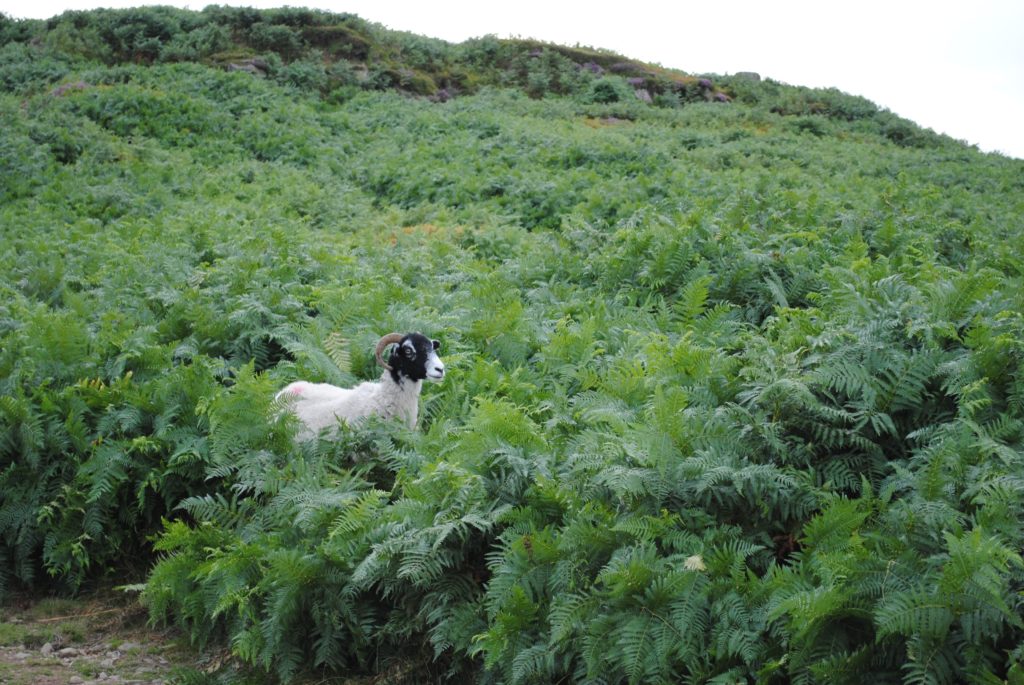Bracken Control on Ilkley Moor
The issue of bracken control was raised at our most recent Committee Meeting. Those of us who have been members of FoIM for a long time will remember that it was the issue of bracken on the Moor that first led to the creation of FoIM. We realise that many more recent members may not be fully aware of all the issues concerning bracken and bracken control. We are therefore grateful to Ian Condliffe who has written the following article, so that all members may have an understanding of the subject.
BRACKEN
For those of you who like to wander on the less used footpaths on the lower areas of Ilkley Moor, summertime can be particularly trying as many of our narrower footpaths get swamped by bracken. Indeed, many seem to disappear altogether! The thick beds of bracken are seen as a nuisance, limiting access, harbouring ticks and choking out the heathland vegetation. Farmers don’t like bracken either as it reduces the grazing area, sheep get lost in it at gathering times and, again, it harbours ticks. Its rhizomes can also damage archaeological features.
People who have a soft spot for bracken are few and far between and it has limited ecological value. Fossil evidence shows that the plant has been around for at least 55 million years and pollen analysis of deep soil cores indicate that its original natural habitat in the UK was in and around open woodland. It is considered to be the world’s most successful fern growing on all continents other than Antarctica. I would suggest that it is also one of the most successful of all plants on earth in terms of colonisation of habitats and its almost indestructibility. It’s a pity that humankind has been unable to find a large-scale economic use for its fronds.
There are several reasons why bracken gets a bad press. The main one is that it takes over valuable upland grazing area and heather moorland used for grouse shooting. It is believed that the fronds and spores have carcinogenic properties that pose a threat to livestock and maybe humans. Laboratory tests have shown that intestinal tumours can occur in animals fed on unprocessed and processed fronds. I mention processed as young ‘fiddle-head’ fronds lightly boiled or pickled are considered a delicacy in Japan and are also eaten in the north and south America and China. To date, according to research published by the BMJ there is an ongoing concern about bracken and cancer in humans, but research has been unable to show any direct links to date. The same goes for bracken spores. Fortunately, high levels of spore release only occur every few years and, as a precaution, people working amongst bracken at that time may be advised to wear a face mask.
The greater to risk to human and animal health comes from bracken harbouring sheep ticks. Ticks can carry a number of diseases and, if you’re unlucky, a bite from a tick can give you, or your dog, Lyme disease. If you are a grouse or sheep you can contract Louping ill. Fortunately, it is believed such diseases are uncommon on Ilkley Moor as the tick population is thought to be relatively low compared too other moorlands where there are higher numbers of hosts such as grazing livestock, deer, rabbits and grouse.
The secret of bracken’s success lies in its rhizome which is really an underground horizontal stem from which the fronds appear. A bracken ‘stand’ can cover well over a hectare and is, in fact all one plant. To make a start on removing it you need to destroy not only all the fronds but the rhizome which may be up to a metre below the surface. Farmers and moorland managers rarely say that they have killed bracken, the word that they use is “control.” It only needs a small amount of rhizome to survive chemical or mechanical control and it is soon putting up fronds, gaining energy and expanding. Furthermore, the rhizome can release chemical compounds that inhibit the growth of competitor plant species.
It does seem that the area of bracken on the moor is on the rise. The plant thrives on well drained relatively fertile soil which is the main reason it occupies only the lower areas of the moor. It cannot thrive in wet or waterlogged soils. Its fronds are susceptible to frost so it tends to have an altitudinal limit and climate change seems to be allowing it to creep up the hill so long as soils are favourable. There is also less sheep grazing on the moor and, although sheep don’t eat the plant, the trampling effect around the heathland edges of the stands can limit its expansion.
The Friends of Ilkley Moor are very aware about how bracken can limit public access, especially in summer. Of equal concern is the slow loss of heather moorland habitat to this invasive species. About 10 years ago the Friends and Bradford Countryside Service funded aerial spraying of about 60ha of bracken around the Cow and Calf and the old golf course. Areas targeted were those where the bracken cover was relatively thin and there was heathland vegetation underneath. The spraying killed most of the bracken fronds giving the moorland vegetation a chance to recover. However, the bracken will also recover over the following years if the emerging fronds aren’t sprayed with herbicide or cut back. Unfortunately, neither the Friends nor the Countryside Service had the resources for follow-up treatment, so these beds have slowly thickened up again.
We are now considering carrying out some limited bracken control in very targeted areas. There are two ways of doing this, applying herbicide or physically cutting and bruising the fronds soon after emergence and again in late summer before the fronds move their sugars back into the rhizome. This is a way of weakening the rhizome network but it needs to be done annually over a number of years to be effective.
Aerial spraying is often the favoured method for treating extensive bracken stands. This, however, is expensive and difficult to do in areas with popular public access, and with lots of small water courses that require 50m spray-free buffer zones. The chemical used, Asulam which kills only bracken (and other ferns) now has limited availability. Herbicides such as Glyphosate have a greater impact on the rhizome but are not licensed for arial application as they will kill most other plants species.
We are therefore considering mechanical control. The often steep and uneven terrain and hidden rocks on the moor make using a tractor or ATV with a flail cutter too dangerous. We are therefore considering hiring a machine commonly called the Flailbot. This is a remote controlled, petrol driven tracked all terrain mowing/flailing machine. It is roughly the same size of a mini-tractor lawn mower designed to operate on terrain too dangerous for manually driven vehicles. If we do, we need be careful not to damage unknown or forgotten archaeological features hidden amongst the bracken. We also need to be confident that we and the Countryside Service have sufficient funds to cut the same areas, spring and late summer, outside the ground nesting bird season in years to come. Unless we do, the bracken will be back!

